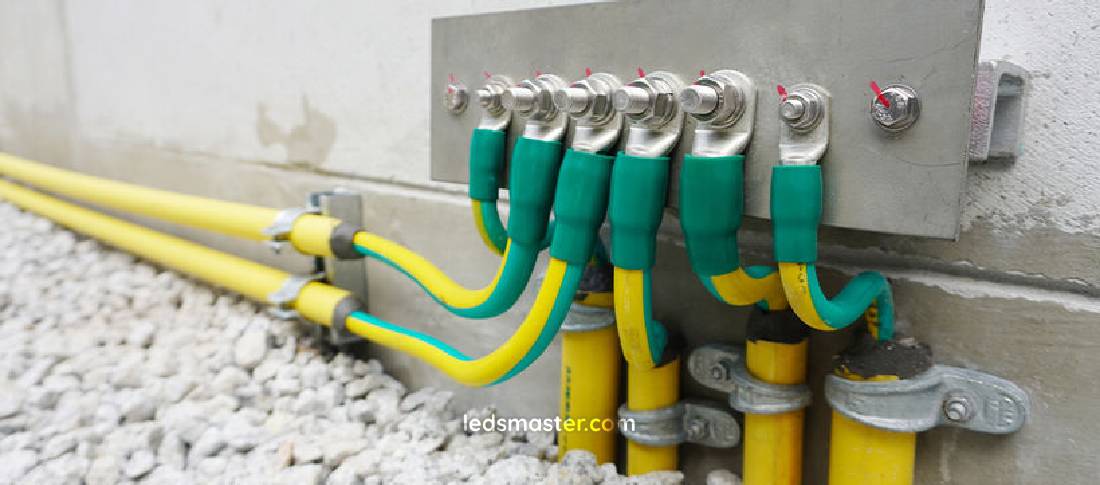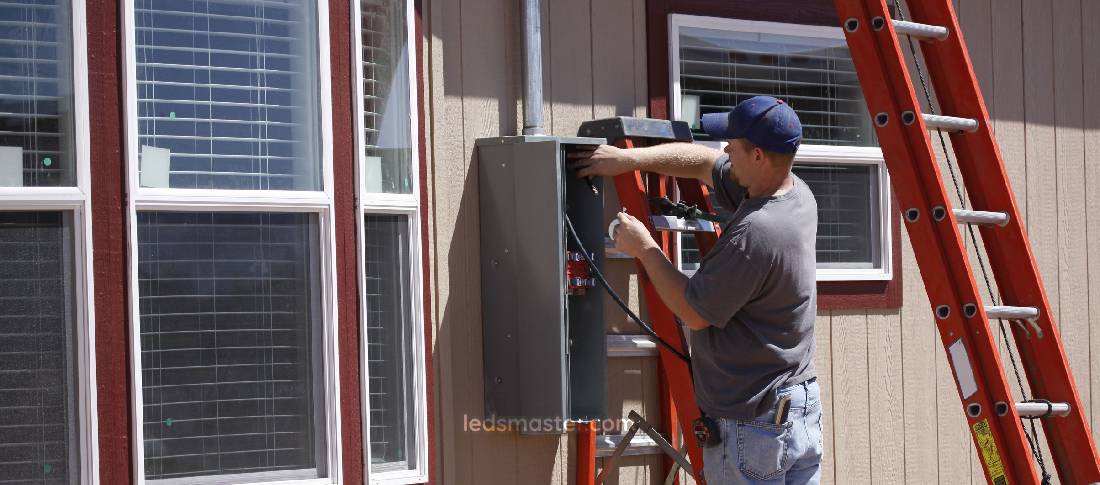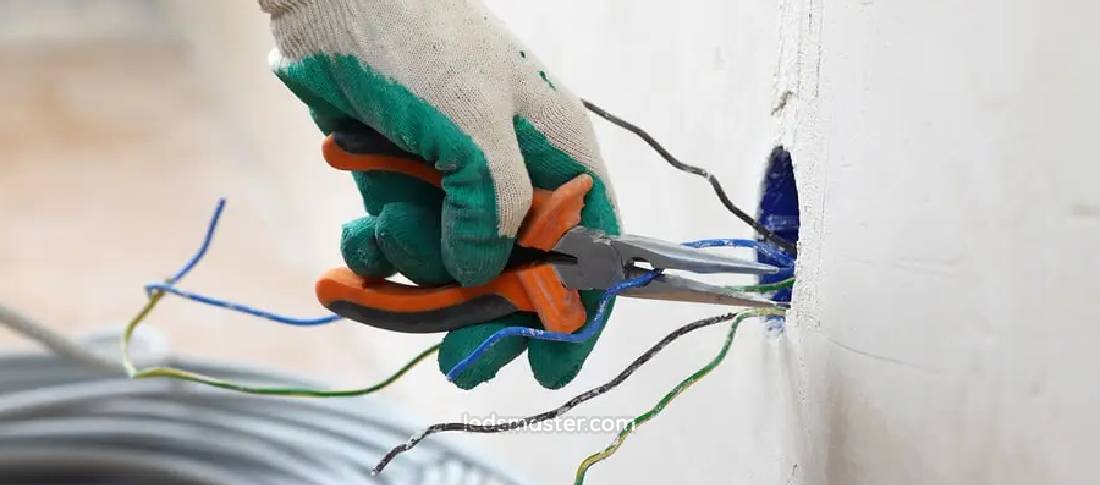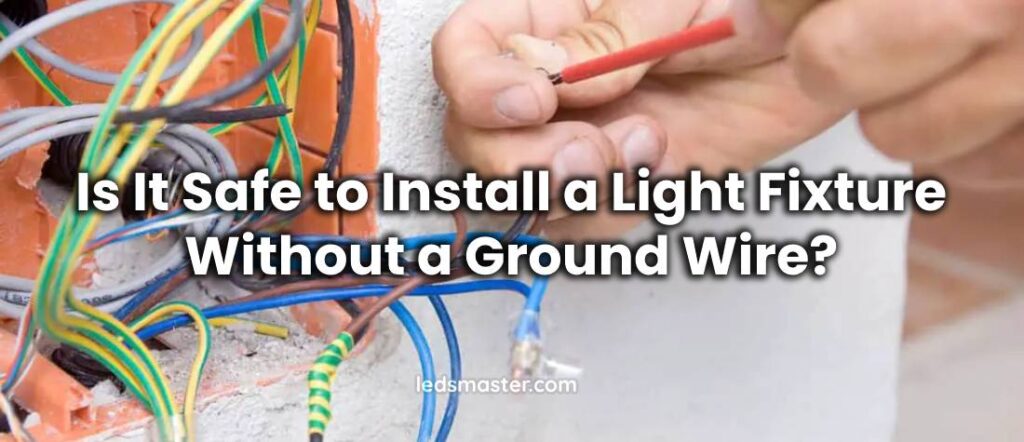When it comes to installing a light fixture, one critical safety consideration is whether it is safe to proceed without a ground wire. The grounding wire is an essential component in electrical systems, designed to protect both people and property from electrical faults. This article explores the function of the grounding wire, its role in light fixture installations, and the implications of omitting it.
Table of Contents
ToggleUnderstanding the Grounding Wire

What is a Grounding Wire?
A grounding wire, often referred to as an earth wire, is a critical component of an electrical system designed to ensure safety by directing stray electrical currents safely away from both people and sensitive equipment. This wire typically appears as either a bare conductor or one insulated with green or green-and-yellow stripes, and it is connected to a grounding point, which could be a grounding rod driven into the earth or part of the building’s grounding system.
The grounding wire is connected to various metal parts of electrical devices and fixtures, providing a direct path to the ground. This connection helps to prevent electrical shocks by ensuring that any unintended currents do not remain on the metal parts of the electrical system. Instead, these stray currents are safely directed away into the ground, reducing the risk of electrical shock and ensuring that the electrical system operates safely.
Function of the Grounding Wire
The grounding wire’s primary function is to offer a safe pathway for excess electrical current to flow into the earth. This is essential for preventing electrical shocks, which can occur if a fault causes metal parts of an appliance or fixture to become electrically live. Without a grounding wire, there would be no safe way for this excess current to escape, potentially leading to severe electrical shocks when someone touches the fixture or appliance.
Furthermore, the grounding wire plays a vital role in reducing the risk of electrical fires. In the event of an electrical fault, such as a short circuit or insulation breakdown, the grounding wire helps to redirect excess current away from flammable materials. By channeling this current safely into the ground, it minimizes the risk of overheating and potential fires, which can be caused by electrical faults.
How the Grounding Wire Works
In a properly grounded electrical system, the grounding wire works in conjunction with other safety devices to protect users and equipment. When an electrical fault occurs—such as a short circuit, where live wires come into contact with metal parts or insulation failure, causing live wires to touch other parts of the fixture—the excess current is directed through the grounding wire.
This redirection of current causes the circuit breaker or fuse to trip. Circuit breakers are designed to detect an overload or short circuit and automatically cut off the power supply to the affected circuit. This action prevents the risk of electrical shock and reduces the likelihood of electrical fires. Similarly, fuses serve the same purpose but by melting to break the circuit.
Grounding wires work in tandem with these safety devices, providing an additional layer of protection. They ensure that any fault current is safely channeled away from users and sensitive equipment, helping to maintain overall electrical safety and system reliability.

Installing a Light Fixture: The Role of the Ground Wire
Importance of the Ground Wire in Light Fixture Installation
When installing a light fixture, the grounding wire is essential for ensuring the fixture’s safety. Light fixtures often include metal parts that can become electrically live if a fault or short circuit occurs. Without proper grounding, these metal components present a significant risk of electrical shock to anyone who comes into contact with them or nearby surfaces.
The grounding wire serves as a crucial safety measure by connecting these metal parts to the grounding system of the building. This connection provides a direct pathway for any stray electrical currents or faults to safely flow into the ground, reducing the risk of electrical shocks. By ensuring that the metal parts of the fixture are grounded, the grounding wire helps to protect users from potentially dangerous situations and maintains overall electrical safety.
Procedure for Connecting the Ground Wire
Turn Off the Power
Before beginning the installation of a light fixture, the first and foremost step is to turn off the power at the circuit breaker. This precaution is vital to avoid any risk of electrical shock while handling the fixture and making connections. Verifying that the power is off with a voltage tester before proceeding is an important safety measure.
Prepare the Ground Wire
If the light fixture includes a ground wire, it should be connected to the corresponding ground wire in the junction box or the building’s grounding system. Typically, the grounding wire in the junction box is either bare or insulated with green or green-and-yellow stripes.
Ensure that the grounding wire from the light fixture is properly aligned with the grounding wire in the junction box. If the fixture does not come with a grounding wire but is designed for a grounded installation, confirm that the grounding system is appropriately set up according to the manufacturer’s guidelines.
Secure the Connections
Use wire nuts to join the grounding wire from the light fixture to the grounding wire in the junction box. It is essential to make sure that these connections are tight and properly insulated. Loose connections can lead to poor grounding and increase the risk of electrical faults. After securing the wire nuts, gently tug on the wires to ensure that they are firmly connected and not at risk of becoming dislodged.
Mount the Fixture
Once the grounding wire is securely connected, proceed to attach the light fixture to the mounting bracket. Ensure that the fixture is properly aligned and that the grounding wire remains correctly connected throughout the installation process. Tighten all screws and mounting hardware to secure the fixture firmly in place.
Final Inspection
After installing and securing the fixture, perform a final inspection to ensure that all connections are secure and that the grounding wire is properly connected. Turn the power back on at the circuit breaker and test the fixture to confirm that it is operating correctly. If there are any issues or concerns, consult a licensed electrician to ensure that the installation meets all safety and code requirements.

Potential Risks of Omitting the Ground Wire
Electrical Shock Hazard
Omitting the grounding wire in a light fixture installation significantly increases the risk of electrical shock. In a properly grounded system, the grounding wire provides a safe path for any stray or fault current to flow into the earth. This is crucial for preventing metal parts of the fixture, which could become electrically live if an electrical fault occurs, from posing a danger to users.
Without a grounding wire, if a fault happens—such as a short circuit where live wires come into contact with the metal parts of the fixture—those metal parts could carry live electrical current. This current can create a hazardous situation where anyone touching the fixture or nearby surfaces might receive a severe electrical shock. This risk is especially concerning in environments where fixtures are frequently handled or touched, such as in residential settings or public spaces. Proper grounding is essential to ensure that these metal parts do not become electrified, protecting individuals from potential harm.
Fire Risk
In addition to the risk of electrical shock, omitting the grounding wire can lead to serious fire hazards. Electrical faults, such as short circuits or insulation failures, can cause excess current to flow through unintended paths. If these faults are not properly grounded, the resulting excess current can lead to overheating of wires, connections, or nearby materials.
Overheating is a major risk factor for electrical fires, as it can ignite flammable materials or cause insulation to melt, potentially leading to a blaze. The grounding wire helps mitigate this risk by providing a controlled path for excess current to safely dissipate into the ground. This prevents the overheating of components and reduces the likelihood of a fire starting due to electrical issues. Without this safety measure, the potential for such fires increases, endangering both people and property.
Code Compliance Issues
Electrical codes and standards, such as the National Electrical Code (NEC) in the United States, have strict requirements for grounding electrical installations. These codes are designed to ensure safety and reliability in electrical systems, and they mandate that most electrical fixtures, including light fixtures, must be properly grounded.
Failing to install a grounding wire not only compromises safety but also results in non-compliance with these essential regulations. This can lead to several legal and practical consequences, including fines, penalties, or required rework to bring the installation up to code. Moreover, if an incident occurs—such as an electrical shock or fire—due to improper grounding, it may lead to legal liabilities or insurance claims complications. Compliance with electrical codes is crucial not only for safety but also for meeting legal requirements and avoiding potential legal and financial repercussions.
Legal and Safety Standards
Electrical Codes and Regulations
Electrical codes and regulations are crucial in maintaining safety and ensuring the reliability of electrical installations. In the United States, the National Electrical Code (NEC) sets the standard for safe electrical design, installation, and inspection. The NEC mandates that all electrical systems, including light fixtures, must be properly grounded to ensure safety. These codes are periodically updated to reflect advancements in electrical technology and safety practices, addressing potential hazards and improving standards for electrical installations.
The NEC’s grounding requirements are designed to protect both users and property by establishing safe practices for handling electrical faults. For example, the code specifies the types of grounding conductors and their connections to ensure that any fault current is directed safely into the ground. Compliance with these regulations is not just a matter of following legal requirements; it is essential for preventing electrical shocks, fires, and other hazards that can arise from improperly grounded systems.
Local electrical codes may vary, but they generally align with the NEC’s principles and provide additional requirements specific to regional conditions and practices. Adhering to these local regulations is important for ensuring that installations meet all necessary safety and legal standards. Inspectors and electricians are responsible for understanding and applying these codes to ensure that electrical systems are installed and maintained correctly.
Industry Best Practices
Industry best practices emphasize the importance of proper grounding in all electrical installations. Certified electricians and other professionals in the electrical industry follow these best practices to ensure that installations are safe, reliable, and compliant with current codes and standards. These practices are developed based on extensive experience, research, and advances in electrical technology.
Ensuring Proper Grounding Connections
One of the core best practices is ensuring that grounding connections are made correctly. This involves connecting grounding wires to all metal parts of electrical fixtures and ensuring that they are securely fastened with appropriate connectors, such as wire nuts. Proper grounding connections are critical for creating a low-resistance path for fault currents to flow safely into the ground.
Using Quality Materials and Components
Best practices also involve using high-quality materials and components for grounding systems. This includes using properly rated grounding wires and connectors that meet or exceed industry standards. High-quality materials help to ensure the longevity and effectiveness of the grounding system, reducing the likelihood of failures that could compromise safety.
Regular Inspections and Maintenance
Regular inspections and maintenance are integral to best practices in grounding. Periodic checks of grounding connections, wiring, and grounding electrodes ensure that the system remains in good condition and continues to function correctly. Certified electricians are trained to identify potential issues and perform necessary repairs or upgrades to maintain system safety.
Training and Certification
Industry best practices also include ensuring that electricians and installers are properly trained and certified. Professional certification ensures that individuals have the knowledge and skills required to perform electrical installations and maintenance safely. Continuous education and training help professionals stay updated on the latest codes, technologies, and safety practices.
Adhering to Manufacturer Instructions
Following manufacturer instructions for the installation and grounding of electrical fixtures is another important best practice. Manufacturers provide specific guidelines on how to properly ground their products, and adhering to these instructions helps ensure that the installation is safe and compliant with relevant standards.
Addressing Common Concerns
What if My Fixture Doesn’t Have a Ground Wire?
If your light fixture does not include a ground wire, it is essential to determine whether it is designed to operate safely without one. Modern fixtures are sometimes manufactured with double insulation, which means they are designed to be inherently safe without the need for a ground wire. These fixtures have additional insulation layers that prevent electrical faults from coming into contact with the user, thus reducing the risk of electrical shock even in the absence of a grounding wire.
However, the absence of a ground wire does not automatically guarantee that the fixture is safe for all installations. To ensure that the fixture is compatible with your existing electrical system, you should consult the manufacturer’s specifications. Manufacturers provide detailed information about the installation requirements and safety features of their products, including whether a ground wire is necessary.
If there is any uncertainty about whether your fixture can be safely installed without a ground wire, it is highly advisable to consult a licensed electrician. An electrician can assess the fixture and the overall electrical system to ensure that everything is correctly configured and compliant with safety standards. They can also recommend any necessary adjustments or additional safety measures to protect against potential hazards.
How Can I Check If My Electrical System is Properly Grounded?
To verify whether your electrical system is properly grounded, you can undertake several steps to ensure that your system meets safety requirements.
Visual Inspection
Start with a visual inspection of your electrical system. Check for the presence of grounding wires connected to the metal parts of your electrical fixtures, outlets, and other components. These wires should be securely attached and properly connected to the building’s grounding system. Look for green or bare copper wires, which indicate grounding connections. Ensure that grounding wires are not damaged or disconnected.
Use of a Grounding Tester
A grounding tester is a useful tool for checking the integrity of your grounding system. This device can be plugged into an electrical outlet to test whether the outlet is properly grounded. Grounding testers typically have indicator lights that show the status of the grounding, as well as other potential wiring issues. Follow the instructions provided with the tester to perform the test accurately.
Hire a Licensed Electrician
For a more comprehensive assessment, it is advisable to hire a licensed electrician. An electrician can perform a detailed inspection of your electrical system to ensure that it is properly grounded and compliant with current safety standards. They have the expertise and tools to identify any grounding issues that may not be apparent through visual inspection or basic testing. An electrician can also provide recommendations for any necessary repairs or improvements to enhance system safety.
Check for Compliance with Safety Standards
Ensure that your electrical system complies with relevant safety standards and codes. A licensed electrician can verify that your system adheres to local regulations and industry best practices. Compliance with these standards is crucial for ensuring that your grounding system effectively protects against electrical hazards.
Conclusion
Grounding is a fundamental aspect of electrical safety that cannot be overlooked during light fixture installations or any other electrical work. The grounding wire plays a crucial role in protecting users and property by providing a safe path for stray electrical currents, thereby preventing electrical shocks and reducing fire risks. Whether dealing with fixtures that come with or without a ground wire, it is essential to understand and verify the grounding requirements to ensure compliance with safety codes and regulations. Proper installation and regular maintenance, guided by industry best practices, are vital to maintaining a safe and reliable electrical system. Consulting with a licensed electrician can provide additional assurance that all grounding measures are correctly implemented, ultimately safeguarding both individuals and property from potential electrical hazards.

